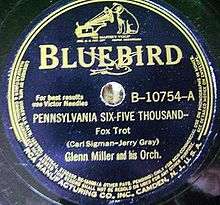PEnnsylvania 6-5000
.jpg)
PEnnsylvania 6-5000 is a telephone number in New York City, written in the 2L+5N (two letters, five numbers) format that was common in the largest US cities from approximately 1930 into the 1960s. The named Pennsylvania exchange served the area around Penn Station in New York. The two letters, PE, stand for the numbers 7 and 3, making the phone number 736-5000, not including the area code 212 for Manhattan.
The number is best known from the 1940 hit song "PEnnsylvania 6-5000", a swing jazz and pop standard recorded by the Glenn Miller Orchestra. Its owner, the Hotel Pennsylvania, claims it to be the oldest continuing telephone number in New York City.[1] While the hotel opened in 1919, the exact age of the telephone number and the veracity of the hotel's claim are unknown.
Background
At the time of Glenn Miller's popular network radio broadcasts, most local telephone calls in large cities were being dialed directly. All intercity calls required the operator. There were no area codes. The length of local numbers varied widely; four or five digits was more than enough for a small city with a single central office, while separate central offices served individual neighborhoods of larger cities.
In large cities, each central office had one or more telephone exchange names. In the 2L+5N system, used only in large cities, a seven-digit local number was dialed as the first two letters of the exchange name (PE for "PEnnsylvania", the exchange serving the area around Penn Station) and five digits.
The telephone numbering plans implemented by telephone companies did not follow any standard practice until the North American Numbering Plan was created by AT&T in 1947.[2] The first automated dial exchanges in the Bell System were deployed in 1919.[3] When seven-digit telephone numbers were first assigned in New York in 1920,[4] the three-letter four-number (3L-4N) system had represented the number in the format PENnsylvania 5000. Similar systems were used in Boston, Chicago, and Philadelphia. By 1930, the 3L-4N system was changed to a 2L–5N system, using two letters and five digits, and PEN-5000 became PE6-5000,[5][6] much like the BUTterfield central office became BUtterfield 8.
The North American Numbering Plan introduced area codes for the eventually continent-wide implementation of direct distance dialing started in 1951 with a first implementation in Englewood, NJ. Many calls from outside the city were placed through an operator, by requesting "long distance, New York City, Pennsylvania six, five-thousand". The long distance operator would either plug into a labeled "New York City, 2L+5N" trunk and dial PE6-5000 or ask the New York City inbound operator to ring the number. The initial area code assignment gave PEnnsylvania 6-5000 Manhattan's area code, as (212) PE6-5000.
In 1969, the PE6 central office was the first in Manhattan to be converted from a panel switch to a 1ESS switch, temporarily making it a significant part of New York Telephone's service crisis. In 1999, area code 646 was overlaid on 212; in 2003, eleven-digit local calling was imposed on all of New York City, including calls within the same area code.[7] Letters from the original named exchange prefixes are occasionally spotted on old signage in the city, but are increasingly rare.[8]
In popular culture

Many big band names played in the Hotel Pennsylvania's Café Rouge, including the Glenn Miller Orchestra.[9] The phone number became the inspiration for the Glenn Miller 1940 Top 5 Billboard hit of the same name.
The number also inspired the pun title Transylvania 6-5000, used separately as titles for a 1963 Bugs Bunny cartoon and a 1985 full-length live-action film. The number was requested in the film Breakfast at Tiffany's (1961), mentioned by the character Frank Burns in an episode of MASH (season one episode 17), in a mix of the Milli Vanilli song "Baby Don't Forget My Number" (1989),) and used by David Lynch in the third episode of his television series, Twin Peaks (first aired in 1990).)
References
- ↑ "New York's Hotel Pennsylvania Keeps World Trade Center 'Tribute in Lights' Memorial Beaming Forever in Virtual Reality". Hospitality Net. 2009-04-17. Retrieved 2011-08-11.
- ↑ "New York City telephone exchanges".
- ↑ Daniel Engber (January 12, 2014). "Who Made That? (Dial Tone)". The New York Times Magazine. p. MM19. Retrieved December 28, 2014.
- ↑ "New York City telephone exchanges, November 1920 to May 1930".
- ↑ Pollak, Michael (2008-11-14). "Dialing Up History". The New York Times. Retrieved 2011-08-11.
- ↑ "Dial Phones to Bring New Number System". The New York Times. August 24, 1930. Retrieved 2011-08-11.
Company to Alter New York's Technique to Facilitate Mechanical Operation. Will Number Exchanges Two Letters and Numeral to Precede Designation of Station Called. Plan Effective Dec. 15 Largest Revision of Kind Will Make It Possible to Reach Wide Area Without Operator's Aid. To Install System Gradually. Dearth of Exchange Names. Adaptable to Wide Growth.
- ↑ Joyce Cohen (January 23, 2003). "The 10- or 11-Digit Local Call Fosters Anxiety and Shrugs". The New York Times. Retrieved December 28, 2014.
- ↑ "Running the Numbers NYC telephone exchanges". Forgotten NY, Greater Astoria Historical Society.
- ↑ "Office Tower Dooms Hotel Pennsylvania. Hosted Glenn Miller, Duke Ellington – Money". Daily News. New York. 2007-01-05. Retrieved 2011-08-11.